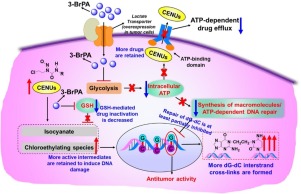当前位置:
X-MOL 学术
›
Toxicology
›
论文详情
Our official English website, www.x-mol.net, welcomes your
feedback! (Note: you will need to create a separate account there.)
Glycolytic inhibition by 3-bromopyruvate increases the cytotoxic effects of chloroethylnitrosoureas to human glioma cells and the DNA interstrand cross-links formation.
Toxicology ( IF 4.8 ) Pub Date : 2020-02-25 , DOI: 10.1016/j.tox.2020.152413 Xiaodong Sun 1 , Guohui Sun 1 , Yaxin Huang 1 , Shufen Zhang 1 , Xiaoyu Tang 2 , Na Zhang 1 , Lijiao Zhao 1 , Rugang Zhong 1 , Yongzhen Peng 3
Toxicology ( IF 4.8 ) Pub Date : 2020-02-25 , DOI: 10.1016/j.tox.2020.152413 Xiaodong Sun 1 , Guohui Sun 1 , Yaxin Huang 1 , Shufen Zhang 1 , Xiaoyu Tang 2 , Na Zhang 1 , Lijiao Zhao 1 , Rugang Zhong 1 , Yongzhen Peng 3
Affiliation

|
DNA interstrand cross-links (ICLs) are essential for the antitumor activity of chloroethylnitrosoureas (CENUs). Commonly, CENUs resistance is mainly considered to be associated with O6-methylguanine-DNA methyltransferase (MGMT) within tumors. Bypassing the MGMT-mediated resistance, to our knowledge, herein, we first utilized a novel glycolytic inhibitor, 3-bromopyruvate (3-BrPA), to increase the cytotoxic effects of l,3-bis(2-chloroethyl)-1-nitrosourea (BCNU) to human glioma cells based on the hypothesis that blocking energy metabolism renders tumor cells more sensitive to chemotherapy. We found 3-BrPA significantly increased the cell killing by BCNU in human glioma SF763 and SF126 cell lines. Significantly decreased levels of extracellular lactate, cellular ATP and glutathione (GSH) were observed after 3-BrPA treatment, and the effects were more remarkable with 3-BrPA in combination with BCNU. Considering that the role of ATP and GSH in drug efflux, DNA damage repair and drug inactivation, we determined the effect of 3-BrPA on the formation of dG-dC ICLs induced by BCNU using stable isotope dilution high-performance liquid chromatography electrospray ionization tandem mass spectrometry (HPLC-ESI-MS/MS). As expected, the levels of lethal dG-dC ICLs induced by BCNU were obviously enhanced after 3-BrPA pretreatment. Based on these results, 3-BrPA and related glycolytic inhibitors may be promising to enhance the cell killing effect and reverse the clinical chemoresistance of CENUs and related antitumor agents.
中文翻译:

3-溴丙酮酸盐的糖酵解抑制作用增加了氯乙基亚硝基脲对人神经胶质瘤细胞的细胞毒性作用和DNA链间交联的形成。
DNA链间交联(ICL)对于氯乙基亚硝基脲(CENU)的抗肿瘤活性至关重要。通常,CENUs耐药主要被认为与肿瘤内的O6-甲基鸟嘌呤-DNA甲基转移酶(MGMT)有关。据我们所知,在本文中,我们绕过了MGMT介导的抗性,首先利用了新型糖酵解抑制剂3-溴丙酮酸(3-BrPA),以增强1,3-双(2-氯乙基)-1-亚硝基脲的细胞毒作用。 (BCNU)对人类神经胶质瘤细胞的研究基于以下假设:阻断能量代谢使肿瘤细胞对化疗更加敏感。我们发现3-BrPA明显增加了人胶质瘤SF763和SF126细胞系中BCNU对细胞的杀伤作用。3-BrPA处理后观察到细胞外乳酸,细胞ATP和谷胱甘肽(GSH)的水平显着降低,3-BrPA与BCNU联合使用效果更显着。考虑到ATP和GSH在药物外排,DNA损伤修复和药物失活中的作用,我们使用稳定同位素稀释高效液相色谱电喷雾串联测定了3-BrPA对BCNU诱导的dG-dC ICL形成的影响。质谱(HPLC-ESI-MS / MS)。不出所料,在3-BrPA预处理后,BCNU诱导的致死性dG-dC ICL的水平明显增加。基于这些结果,3-BrPA和相关的糖酵解抑制剂可能有望增强细胞杀伤作用并逆转CENU和相关抗肿瘤药的临床化学耐药性。我们使用稳定同位素稀释高效液相色谱电喷雾电离串联质谱(HPLC-ESI-MS / MS),确定了3-BrPA对BCNU诱导的dG-dC ICL形成的影响。不出所料,在3-BrPA预处理后,BCNU诱导的致死性dG-dC ICL的水平明显增加。基于这些结果,3-BrPA和相关的糖酵解抑制剂可能有望增强细胞杀伤作用并逆转CENU和相关抗肿瘤药的临床化学耐药性。我们使用稳定同位素稀释高效液相色谱电喷雾电离串联质谱(HPLC-ESI-MS / MS),确定了3-BrPA对BCNU诱导的dG-dC ICL形成的影响。不出所料,在3-BrPA预处理后,BCNU诱导的致死性dG-dC ICL的水平明显增加。基于这些结果,3-BrPA和相关的糖酵解抑制剂可能有望增强细胞杀伤作用并逆转CENU和相关抗肿瘤药的临床化学耐药性。
更新日期:2020-02-25
中文翻译:

3-溴丙酮酸盐的糖酵解抑制作用增加了氯乙基亚硝基脲对人神经胶质瘤细胞的细胞毒性作用和DNA链间交联的形成。
DNA链间交联(ICL)对于氯乙基亚硝基脲(CENU)的抗肿瘤活性至关重要。通常,CENUs耐药主要被认为与肿瘤内的O6-甲基鸟嘌呤-DNA甲基转移酶(MGMT)有关。据我们所知,在本文中,我们绕过了MGMT介导的抗性,首先利用了新型糖酵解抑制剂3-溴丙酮酸(3-BrPA),以增强1,3-双(2-氯乙基)-1-亚硝基脲的细胞毒作用。 (BCNU)对人类神经胶质瘤细胞的研究基于以下假设:阻断能量代谢使肿瘤细胞对化疗更加敏感。我们发现3-BrPA明显增加了人胶质瘤SF763和SF126细胞系中BCNU对细胞的杀伤作用。3-BrPA处理后观察到细胞外乳酸,细胞ATP和谷胱甘肽(GSH)的水平显着降低,3-BrPA与BCNU联合使用效果更显着。考虑到ATP和GSH在药物外排,DNA损伤修复和药物失活中的作用,我们使用稳定同位素稀释高效液相色谱电喷雾串联测定了3-BrPA对BCNU诱导的dG-dC ICL形成的影响。质谱(HPLC-ESI-MS / MS)。不出所料,在3-BrPA预处理后,BCNU诱导的致死性dG-dC ICL的水平明显增加。基于这些结果,3-BrPA和相关的糖酵解抑制剂可能有望增强细胞杀伤作用并逆转CENU和相关抗肿瘤药的临床化学耐药性。我们使用稳定同位素稀释高效液相色谱电喷雾电离串联质谱(HPLC-ESI-MS / MS),确定了3-BrPA对BCNU诱导的dG-dC ICL形成的影响。不出所料,在3-BrPA预处理后,BCNU诱导的致死性dG-dC ICL的水平明显增加。基于这些结果,3-BrPA和相关的糖酵解抑制剂可能有望增强细胞杀伤作用并逆转CENU和相关抗肿瘤药的临床化学耐药性。我们使用稳定同位素稀释高效液相色谱电喷雾电离串联质谱(HPLC-ESI-MS / MS),确定了3-BrPA对BCNU诱导的dG-dC ICL形成的影响。不出所料,在3-BrPA预处理后,BCNU诱导的致死性dG-dC ICL的水平明显增加。基于这些结果,3-BrPA和相关的糖酵解抑制剂可能有望增强细胞杀伤作用并逆转CENU和相关抗肿瘤药的临床化学耐药性。











































 京公网安备 11010802027423号
京公网安备 11010802027423号